7 Platforms to Find Your Next SaaS Business Idea in 2025
The digital landscape is booming, and the demand for innovative Software-as-a-Service (SaaS) solutions has never been higher. Yet, the first and most crucial step for any aspiring entrepreneur is finding a viable SaaS business idea—one that solves a real problem for a specific audience. The challenge isn't a lack of opportunities, but rather knowing where to look and how to separate fleeting trends from genuinely profitable ventures. A great idea needs a solid foundation built on market research, trend analysis, and a clear path to validation.
This guide moves beyond generic brainstorming. We will explore seven distinct platforms and resources that serve as powerful launchpads for discovering, validating, and even acquiring your next SaaS business. Whether you want to generate a concept from scratch, buy an existing project with proven traction, or simply immerse yourself in the latest market trends, these tools provide the structured insights you need.
Each entry in this list will provide a deep dive into the platform, complete with screenshots and direct links, so you can start your research immediately. We'll break down how each resource works, its unique advantages, and how you can leverage it to find a SaaS business idea that aligns with your skills and market demand. This practical approach is designed to help you find and vet a concept that sets you up for success in 2025 and beyond.
1. SaaSThink
SaaSThink is a cutting-edge, AI-powered platform designed specifically to address the first and most critical step for any entrepreneur: finding a viable SaaS business idea. It moves beyond generic brainstorming by leveraging sophisticated algorithms to analyze market trends, competitor landscapes, and real-world user challenges. This data-driven approach empowers founders to generate unique, market-ready concepts in a fraction of the time traditional research would take.
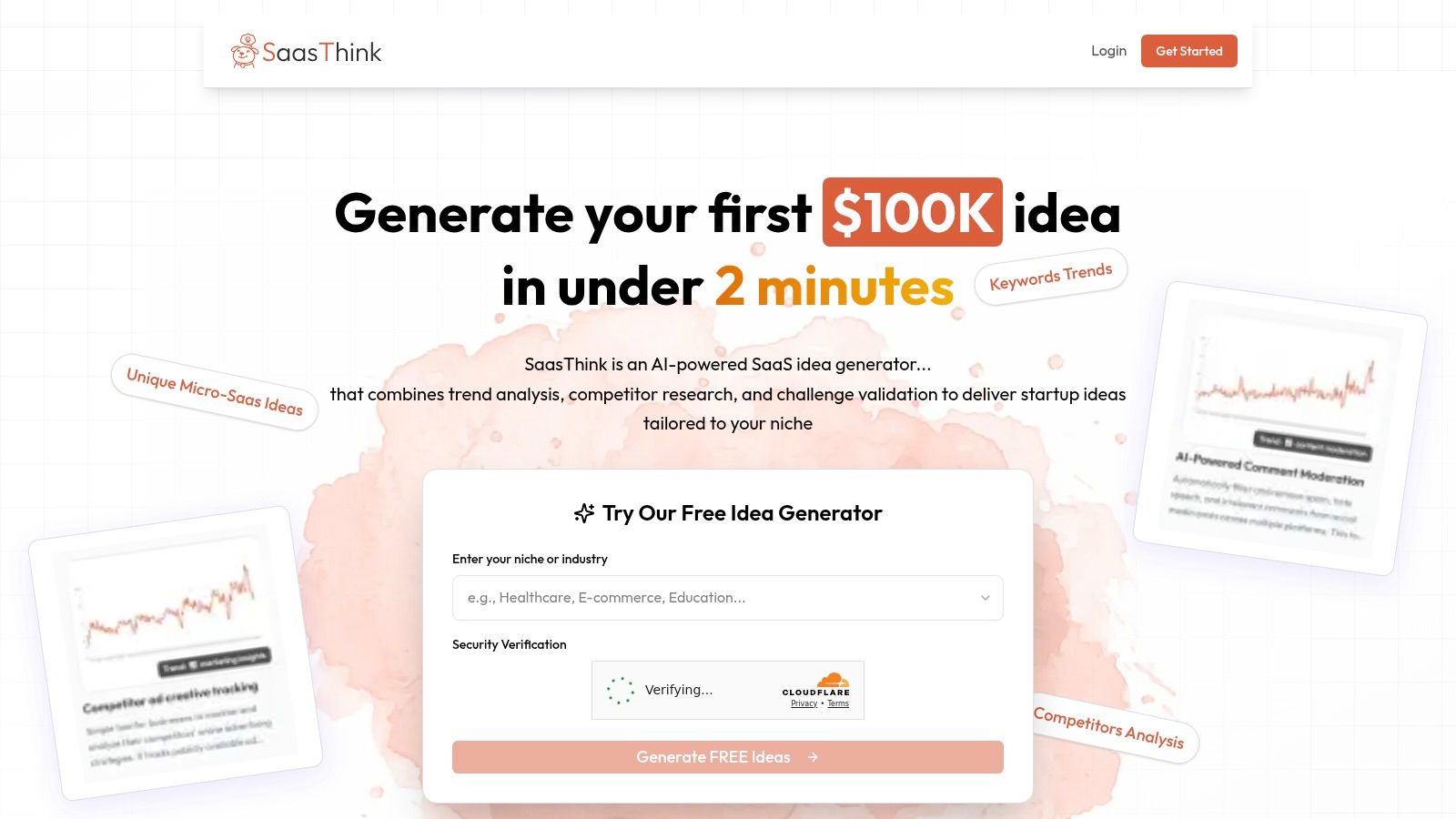
What sets SaaSThink apart is its comprehensive validation framework built directly into the idea generation process. Instead of just providing a list of concepts, the platform delivers a full-spectrum analysis that includes key metric visualizations, keyword trend tracking, and an AI-driven competition overview. This integration of ideation and validation significantly reduces the risk and uncertainty that often paralyzes new ventures, ensuring that every generated idea is not only innovative but also grounded in market reality.
Key Strengths and Capabilities
SaaSThink is more than just an idea generator; it's an initial market research and validation tool. Its core strength lies in its ability to synthesize complex data points into actionable insights, making it an indispensable resource for both first-time founders and experienced entrepreneurs looking to pivot or expand.
- AI-Powered Idea Generation: The platform's primary function is its ability to produce customized SaaS ideas in under two minutes. Users can input specific industries, target audiences, or problem areas, and the AI will generate concepts tailored to those parameters.
- Comprehensive Market Insights: For each idea, SaaSThink provides a dashboard with vital data, including potential market size, relevant keyword search volumes, and emerging trends. This allows users to quickly gauge demand and strategic positioning.
- Competitor Analysis: An integrated AI tool analyzes the existing competitive landscape, identifying key players, their strengths, and potential gaps in the market. This feature is crucial for developing a unique value proposition.
- Pre-Validated Idea Library: For those seeking immediate inspiration, SaaSThink offers an extensive library of pre-vetted ideas. These concepts have already undergone an initial layer of market analysis, providing a reliable starting point for further exploration.
User Experience and Accessibility
The platform is designed with a clean, intuitive user interface that makes navigating its powerful features straightforward. The process is streamlined to guide users from initial query to detailed idea analysis without a steep learning curve. This focus on user experience ensures that entrepreneurs can focus on the ideas themselves rather than on learning a complex tool.
Accessibility is a major advantage. SaaSThink offers flexible subscription tiers, including a robust no-cost option. This free plan provides access to the core idea generation engine, making it an excellent resource for aspiring founders operating on a tight budget. Premium plans unlock deeper analytics, unlimited idea generation, and more advanced market insights, scaling with the user's needs.
| Feature Comparison | Free Plan | Premium Plans |
|---|---|---|
| AI Idea Generation | Limited | Unlimited |
| Pre-Validated Library | Access | Full Access |
| Keyword Trend Data | Basic | Advanced |
| Competitor Analysis | Overview | In-Depth |
| Key Metric Visualization | Limited | Full |
Practical Tips for Effective Use
To maximize the value you get from SaaSThink, approach it with a strategic mindset. Start by defining a broad niche or problem you are passionate about solving. Use the generator to explore different angles within that space. Once you have a shortlist, dive into the competitor analysis and keyword trend data for each idea. This will help you identify the concept with the clearest path to market entry and the most significant growth potential. For more advanced strategies, you can learn more about effective SaaS idea generation on their blog.
Website: https://www.saasthink.app
2. Acquire.com
Why build from zero when you can start on third base? Acquire.com offers a fundamentally different approach to launching your next SaaS business idea: buying an existing one. It's a curated marketplace for acquiring startups, micro-SaaS projects, and e-commerce businesses that already have a product, customers, and often, revenue. This platform transforms the daunting task of starting from scratch into a strategic acquisition, allowing you to bypass the treacherous early stages of product-market fit.
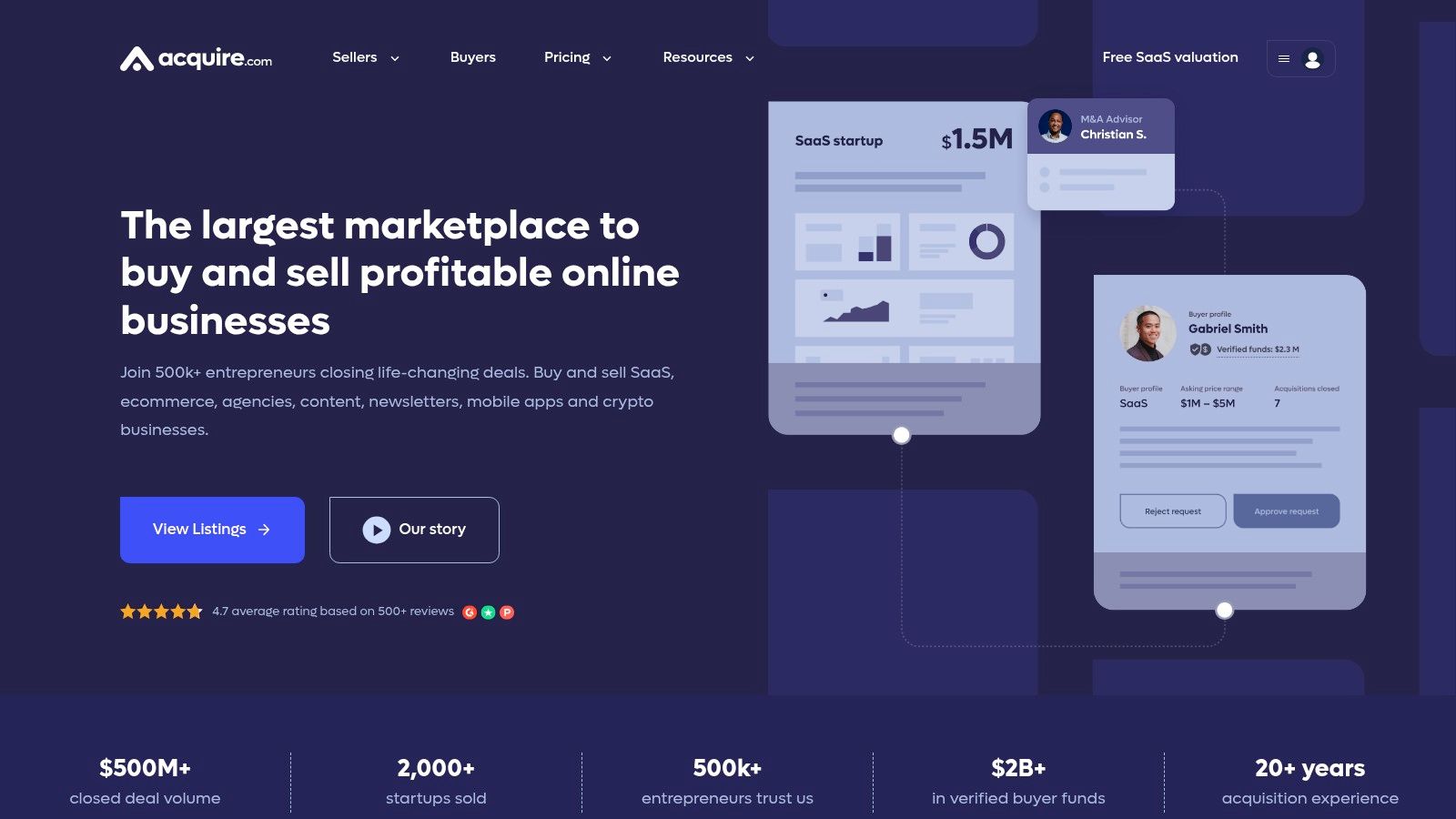
Acquire.com stands out by creating a serious, vetted environment for both buyers and sellers. Unlike general business forums, its focus is on tech and SaaS companies, providing detailed, verified metrics like Monthly Recurring Revenue (MRR), traffic, and customer data. This transparency helps you make informed decisions quickly.
Key Features and User Experience
The platform is designed to facilitate a smooth and secure transaction from initial contact to final closing. It’s more than just a listing site; it’s a guided acquisitions manager.
- Vetted Listings: Each startup is screened, ensuring you see legitimate businesses with verified financials.
- Guided Process: Acquire.com provides a step-by-step framework, including integrated legal document templates for Letters of Intent (LOI) and Asset Purchase Agreements (APA).
- Integrated Escrow: It offers a no-fee escrow service through partners like Escrow.com and SRS Acquiom, securing funds and ensuring a safe transfer of assets.
- Direct Communication: Once you have a paid membership, you can directly message founders to ask critical questions and start negotiations.
Access to detailed information and the ability to contact sellers requires a paid membership. This paywall acts as a filter, ensuring that only serious buyers are engaging with founders, which improves the overall quality of interactions on the platform.
Pro Tip: Before committing to a purchase, use the platform's messaging to conduct thorough due diligence. Ask the founder for a live demo, access to analytics, and details about their customer acquisition channels and churn rates.
How to Use Acquire.com for Your Next SaaS Venture
To get started, browse the public listings to understand the types of businesses available at different price points. When you find a promising target, upgrading to a premium plan is necessary. The "Buyer" plans unlock private financial details, allow you to contact sellers, and access the platform's acquisition tools.
Here’s a practical approach:
- Define Your Criteria: Determine your budget, ideal niche (e.g., B2B marketing tech, productivity tools), and required revenue level.
- Filter and Research: Use the platform's advanced filters to narrow down listings that match your criteria.
- Engage and Inquire: Once you upgrade, reach out to founders with specific, insightful questions.
- Negotiate and Close: Leverage the built-in LOI templates and secure escrow to formalize the deal.
By acquiring a business, you inherit a validated SaaS business idea with a pre-built foundation, saving you months or even years of development and marketing effort.
3. Flippa
Flippa is one of the oldest and largest marketplaces for buying and selling online businesses, including a vast inventory of SaaS products. It presents an open, auction-style environment where you can find everything from starter projects with minimal traction to established, seven-figure businesses. This broad scope makes it an excellent platform for discovering a new SaaS business idea or acquiring a foundational product to build upon, regardless of your budget.
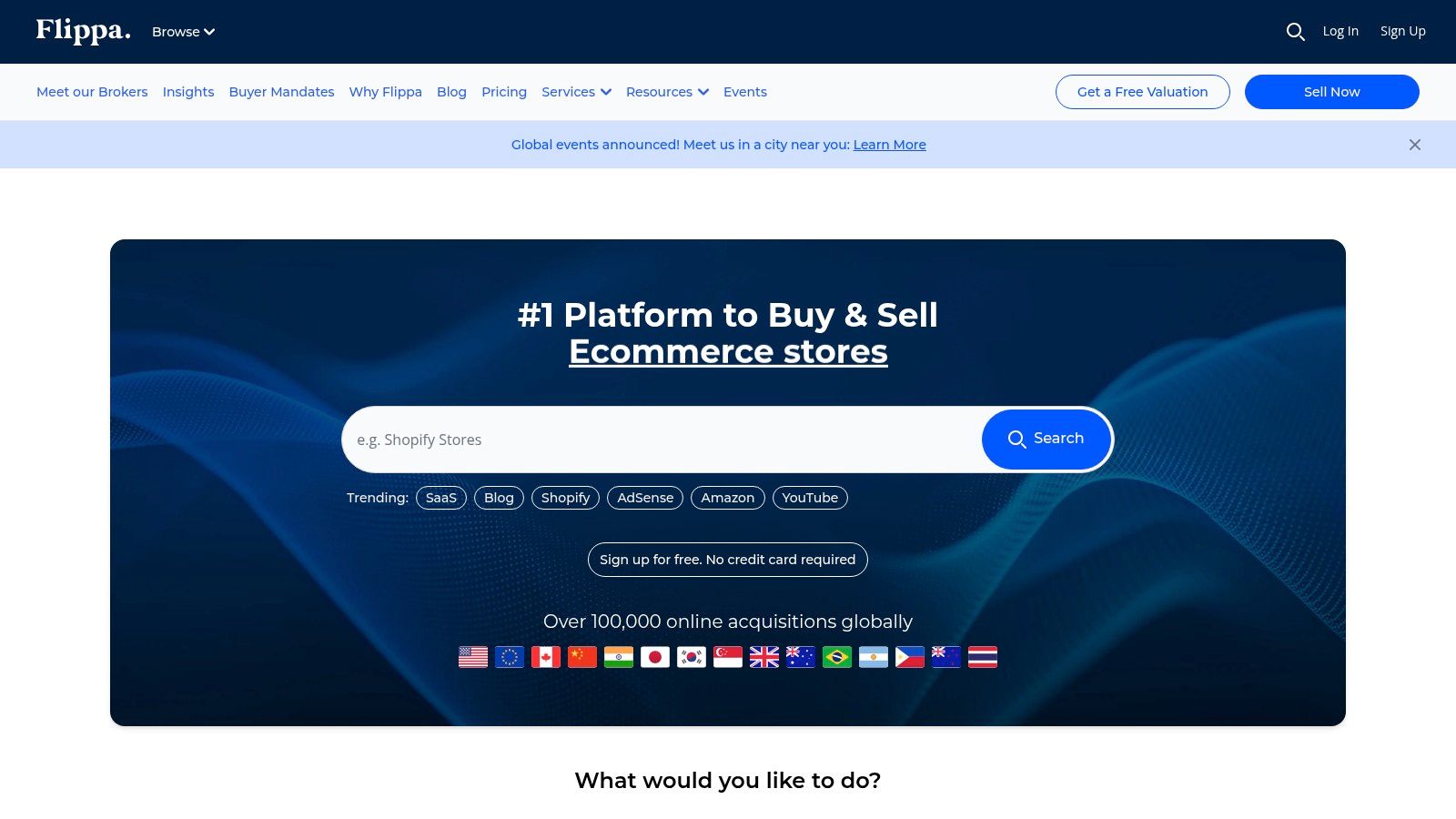
Unlike more curated platforms, Flippa's strength lies in its sheer volume and variety. You can browse countless niches, from marketing automation tools to niche B2B utilities, often at more accessible price points. This makes it a go-to resource for first-time buyers or entrepreneurs looking for a smaller-scale project to grow. The open nature of the marketplace means due diligence is paramount, but the potential to find a hidden gem is significant.
Key Features and User Experience
Flippa's platform is built to handle a high volume of listings and facilitate transactions between a global user base. It functions like a large-scale auction house for digital assets, complete with bidding, "buy it now" options, and negotiation tools.
- Wide Inventory: The marketplace features a massive selection of SaaS businesses, apps, and websites, with listings spanning from pre-revenue ideas to profitable enterprises.
- Integrated Escrow: Flippa partners with Escrow.com to provide a secure payment and asset transfer process, offering discounted fees for its users.
- Verification Options: Sellers can opt into services like a broker-verified program to add a layer of credibility to their listings, though buyers should still perform their own checks.
- Public and Private Communication: You can ask public questions on a listing to clarify details for all potential buyers or communicate privately with the seller to discuss specifics and negotiate terms.
While anyone can browse, engaging in bidding or making offers requires creating an account. The platform's success and listing fees can be a consideration, especially on lower-priced deals, but its extensive documentation provides transparent guidance on all costs involved.
Pro Tip: Look for listings that have been on the platform for a while or have been relisted. Sellers may be more flexible on price and terms, but be extra diligent in understanding why the business hasn't sold yet.
How to Use Flippa for Your Next SaaS Venture
The key to success on Flippa is having a clear strategy and a rigorous due diligence process. The platform’s filters are your best friend for navigating the vast number of listings.
Here’s a practical approach:
- Set Your Budget and Niche: Know what you can afford and what type of business you're looking for. Use filters for price, age, revenue, and business model to narrow your search.
- Scrutinize Listings: Pay close attention to verified revenue claims, traffic sources, and the seller’s history on the platform. Be wary of listings with vague descriptions or unverified data.
- Ask Probing Questions: Use the Q&A feature to ask about customer churn, technology stack, marketing efforts, and the reason for selling.
- Verify Everything: Before making an offer, request read-only access to analytics, payment processor statements, and even a live screen-share walkthrough of the backend.
Flippa can be a goldmine for acquiring a validated SaaS business idea. With a careful, systematic approach, you can find a project that aligns with your skills and budget, saving you from the uncertainties of starting from absolute zero.
4. Product Hunt
Where can you find a daily, real-time pulse of the SaaS market? Product Hunt is the premier destination for discovering new tech products. It operates as a daily leaderboard where new tools launch, gain traction through community upvotes, and spark conversations. This platform is a goldmine for anyone hunting for a SaaS business idea, offering a direct look at what’s trending, what’s resonating with users, and where gaps in the market exist.
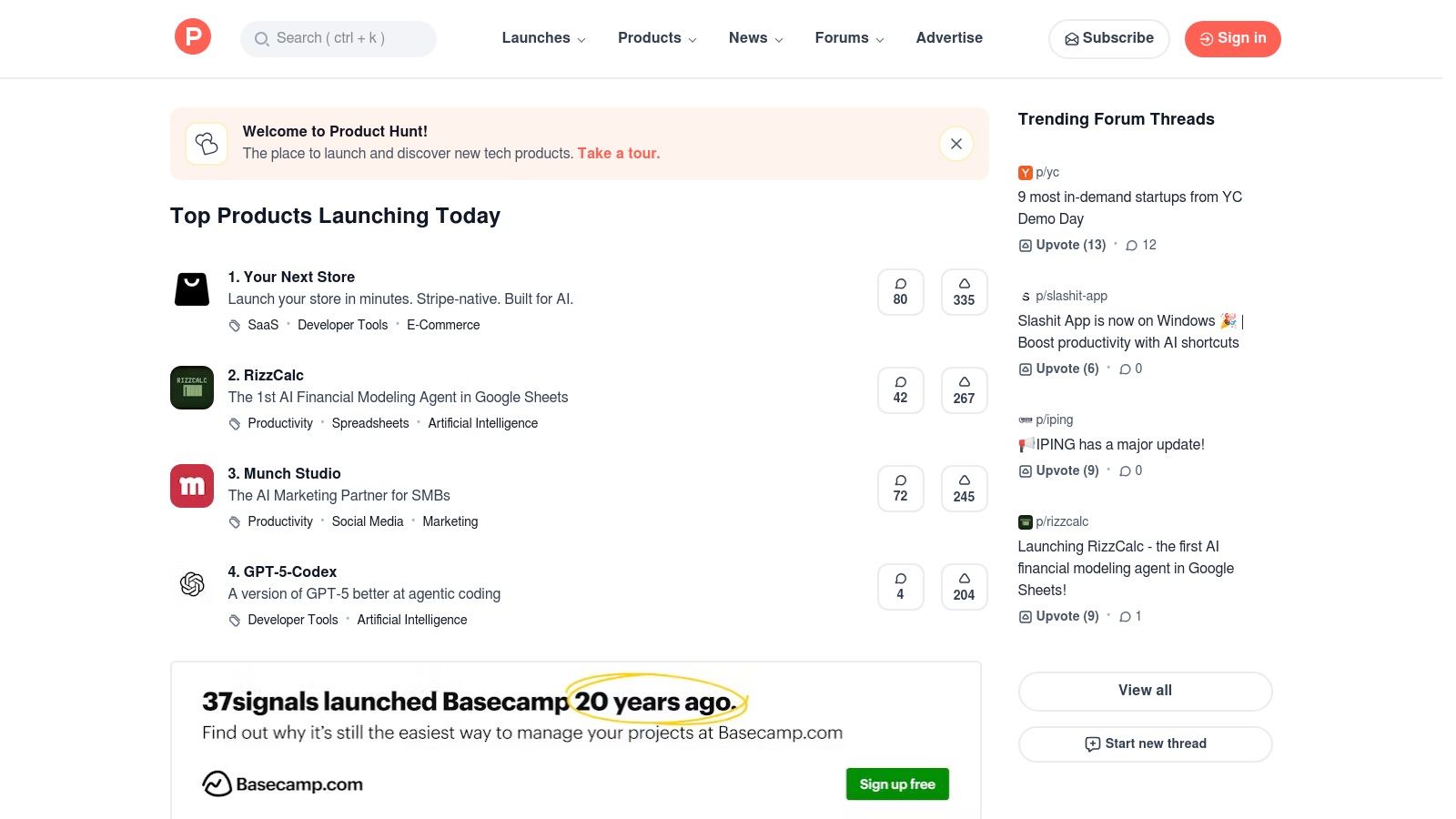
Product Hunt stands out because it's not just a directory; it's a dynamic community. Makers launch their products here to get early feedback, find their first users, and validate their concepts. For an aspiring founder, this provides an unparalleled opportunity to observe the entire launch process, analyze user reactions, and identify underserved niches directly from the source. It’s a free, front-row seat to market validation in action.
Key Features and User Experience
The platform is designed for discovery and interaction. Its leaderboard format makes it easy to see what's popular, while its comment sections provide unfiltered user feedback and direct access to the creators.
- Daily Leaderboard: New products are featured daily and ranked by community upvotes, surfacing the most popular tools.
- Direct Maker Interaction: Engage directly with founders in the comments section to ask questions, understand their journey, and learn about their tech stack.
- Community Voting and Comments: The upvote and comment system serves as a powerful, real-time focus group, highlighting what features and solutions get users excited.
- Launch Guidance: For those ready to build, Product Hunt offers resources and a built-in audience for launching your own product.
Access to browse, vote, and comment is entirely free with a personal account. This open accessibility fosters a vibrant community and a constant flow of new ideas, making it an essential resource for market research without any financial commitment.
Pro Tip: Don't just look at the top-ranked products. Explore the "Newest" tab and niche categories to find less-hyped but potentially high-potential ideas. Pay close attention to the comments section for feature requests and user pain points, which often reveal valuable business opportunities.
How to Use Product Hunt for Your Next SaaS Venture
To leverage Product Hunt effectively, approach it as a market intelligence tool. Your goal is to identify patterns, validate demand, and spark inspiration for your own unique SaaS business idea.
Here’s a practical approach:
- Track Daily Trends: Spend 15-20 minutes each day reviewing the top-ranked products. Note which categories (e.g., AI tools, productivity apps, no-code platforms) are consistently popular.
- Analyze User Feedback: Dive into the comments of products in your niche of interest. Look for recurring complaints, feature requests, or praise that indicates a strong user need.
- Engage with Makers: Ask founders about their biggest challenges, their customer acquisition strategy, or why they chose to solve a particular problem. Their insights are invaluable.
- Identify Gaps: Look for successful products and ask, "What's missing?" or "How could this be better for a different target audience?" Sometimes the best idea is a fresh take on an existing concept. For more on this, you can explore how an app idea generator can help you find your niche.
By consistently using Product Hunt for research, you can move from brainstorming to building a validated SaaS product that people actually want.
5. AppSumo
What if you could test drive dozens of different SaaS business models for a fraction of their usual cost? AppSumo provides a unique angle for validating your next SaaS business idea: by exploring what’s already gaining traction. It’s a leading marketplace for lifetime deals (LTDs) on emerging software, offering a treasure trove of inspiration and affordable tools for aspiring entrepreneurs. Instead of just brainstorming, you can experience a wide range of SaaS products firsthand.
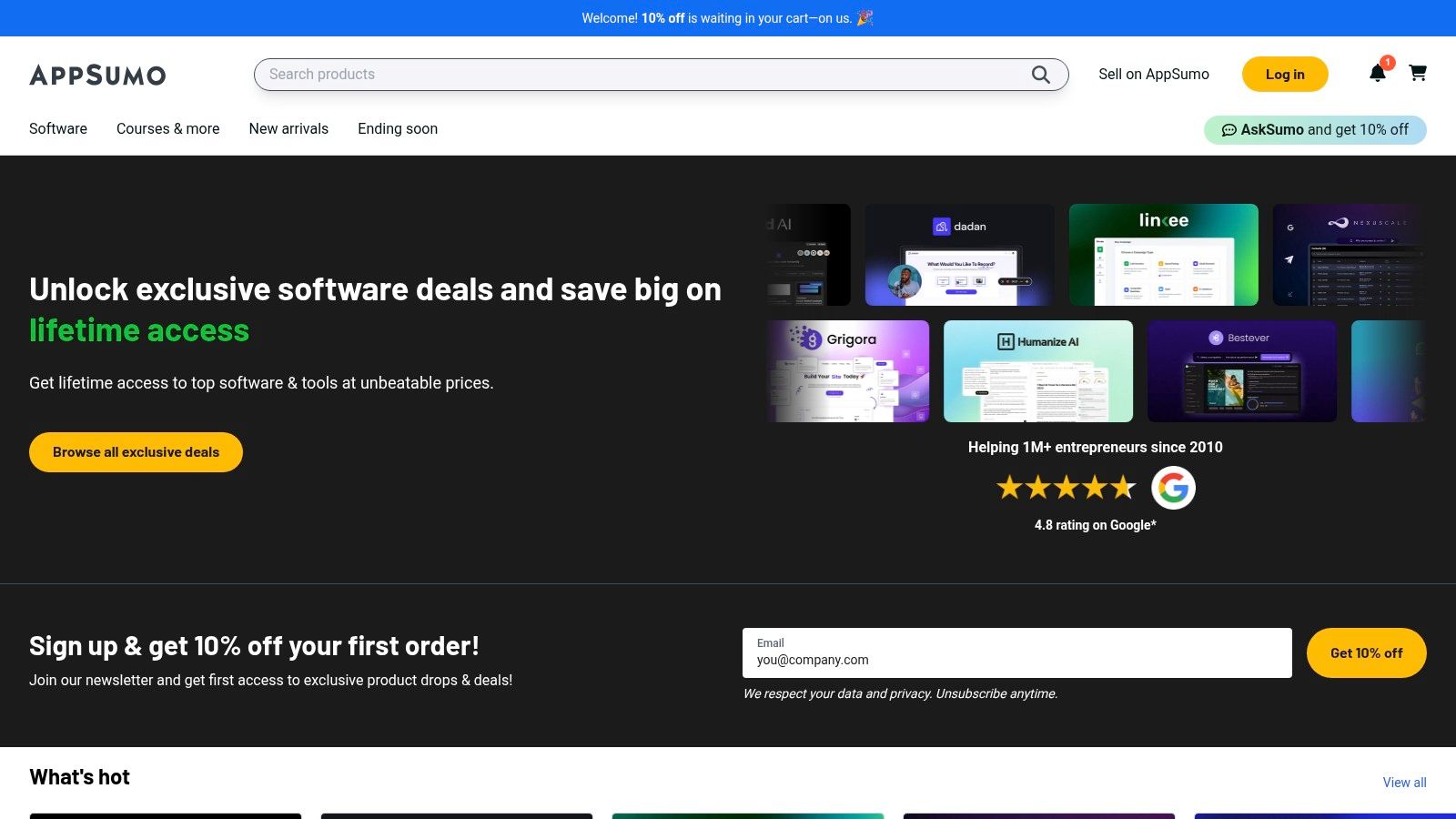
AppSumo stands out because it acts as a launchpad for new SaaS companies. By observing which deals sell out quickly or generate significant buzz in the reviews, you can gain real-time market intelligence. It’s a living catalog of solutions to problems that real businesses are willing to pay for, making it an invaluable resource for market research and idea validation.
Key Features and User Experience
The platform is designed around discovery and low-risk experimentation. The core of the experience is the limited-time deal, creating a sense of urgency and opportunity for both buyers and the SaaS founders listing their products.
- Lifetime Deals (LTDs): The primary offering is a one-time payment for lifetime access to a SaaS tool, which is a massive draw for budget-conscious startups.
- 60-Day Money-Back Guarantee: AppSumo’s signature feature is a no-questions-asked 60-day refund policy on most deals. This allows you to thoroughly test a tool and its market potential without financial risk.
- Active Q&A and Reviews: Each product listing has a vibrant community section where potential buyers ask the founders direct questions and verified users leave candid reviews.
- Wide Variety of Categories: From marketing automation and SEO tools to project management and AI content generators, the platform covers nearly every B2B SaaS niche imaginable.
The user interface is straightforward, making it easy to browse deals by category, popularity, or recent additions. The true value, however, lies in digging into the customer feedback on each deal page to understand user pain points and feature requests.
Pro Tip: Don't just look at the successful deals. Analyze the deals that flop or get poor reviews. Understanding why a SaaS business idea failed to connect with the AppSumo audience can provide lessons just as valuable as studying the winners.
How to Use AppSumo for Your Next SaaS Venture
AppSumo is more than just a place to buy cheap software; it's a strategic tool for ideation and competitive analysis. You can use it to identify underserved niches or find inspiration for a new feature set.
Here’s a practical approach:
- Identify Trending Categories: Regularly browse the "Popular" and "What's Hot" sections to see which types of software are currently in high demand.
- Analyze Competitors: If you have an idea, search for similar tools that have launched on AppSumo. Read the reviews to learn what users loved and, more importantly, what they felt was missing.
- Test the Waters: Purchase deals in your target niche. Use them extensively for 60 days to understand the user experience, core value proposition, and technical limitations.
- Validate a Problem: The questions and reviews on a listing are a goldmine. They reveal the specific problems customers are trying to solve, giving you a clear blueprint for a product that truly meets market needs.
By leveraging AppSumo, you can de-risk your entrepreneurial journey, gathering critical market data and inspiration directly from a community of active SaaS buyers.
6. Starter Story
Why reinvent the wheel when you can learn from thousands of founders who have already built successful businesses? Starter Story is a massive library of case studies, data, and tools designed to help you find and validate your next SaaS business idea. It moves beyond generic advice by providing detailed, real-world examples of how entrepreneurs found their niche, built their product, and grew their revenue, offering a blueprint for your own journey.
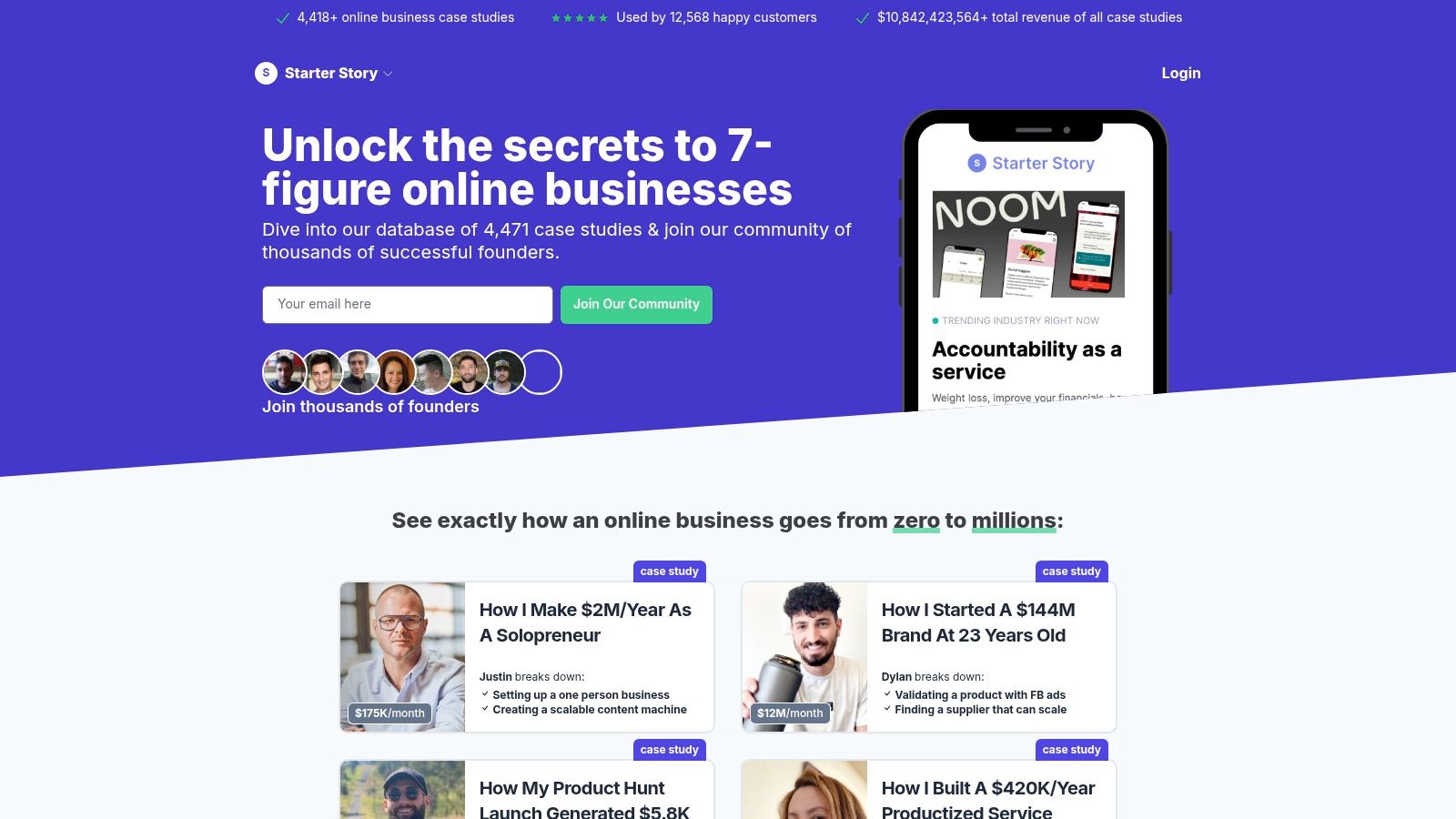
Starter Story stands out by combining inspiration with actionable tools. While other platforms might offer static lists of ideas, Starter Story provides dynamic databases and AI-powered utilities to help you deconstruct, remix, and analyze concepts. It’s a research platform built for aspiring founders who prefer data-driven validation over guesswork.
Key Features and User Experience
The platform is structured to guide you from initial curiosity to a validated business concept, all backed by a community and extensive educational content. It’s a one-stop-shop for the ideation phase of building a business.
- Founder Case Studies: Access over 4,000 interviews with founders who share revenue figures, timelines, marketing strategies, and key lessons.
- Idea Databases: Explore 30+ curated databases covering everything from micro-SaaS and AI tools to profitable niche websites and service businesses.
- AI-Powered Tools: Use the AI Idea Validator to get feedback on your concept or the Idea Remixer to generate new angles on existing business models.
- Educational Courses: Enroll in courses like 'How to Find a $1M Idea' to learn a structured process for ideation and validation.
Most of the in-depth content and advanced tools are behind a paywall. A premium membership is required to unlock the full case studies, access all databases, and use the AI features, which ensures the community consists of serious, committed entrepreneurs.
Pro Tip: Don't just read the success stories. Pay close attention to the "mistakes made" and "lessons learned" sections in each case study. These often contain more valuable insights for avoiding common pitfalls than the success metrics alone.
How to Use Starter Story for Your Next SaaS Venture
To get the most out of the platform, approach it as a structured research tool rather than a passive reading library. The combination of databases, founder stories, and validation tools makes it a powerful resource if used systematically. You can find out more about using tools to generate ideas in our guide on how to use a SaaS idea generator.
Here’s a practical approach:
- Explore the Databases: Start by browsing the idea databases to identify patterns, trends, and niches that align with your interests and skills.
- Deep-Dive into Case Studies: Once you find an interesting niche, read the related case studies to understand the business model, customer acquisition channels, and revenue potential.
- Validate and Remix Your Idea: Use the AI Idea Validator to get an initial assessment of your own SaaS business idea. Use the Remixer to explore new variations.
- Engage with the Community: A paid plan gives you access to a private community where you can ask for feedback and connect with other founders.
Starter Story gives you the tools not just to find an idea, but to build conviction in it through data, examples, and structured analysis.
7. Amazon (Books)
Sometimes the most valuable SaaS business idea isn't found on a tech platform, but within the pages of a well-written book. Amazon's vast marketplace of books offers a low-cost, high-impact resource for aspiring founders. It's a goldmine of strategic playbooks, niche idea collections, and in-depth guides on everything from validating a concept to scaling a business, written by seasoned operators who have already navigated the startup journey. This approach complements digital tools by providing foundational knowledge and structured thinking.
Amazon stands out due to its sheer scale and accessibility. You can instantly download an eBook with hundreds of vetted ideas or order a physical copy of a strategic framework that has guided multi-million dollar companies. The user review and rating system acts as a powerful filter, helping you distinguish high-value, actionable content from low-effort publications. It democratizes access to expert knowledge that was once only available through expensive courses or mentorships.
Key Features and User Experience
The platform is optimized for discovery and immediate consumption, making it an efficient tool for research and learning. You can go from a spark of curiosity to a deep dive into a niche in minutes.
- Massive Selection: Access everything from operator playbooks like "The Mom Test" for validation to niche collections like "Micro-SaaS Ideas" for inspiration.
- Multiple Formats: Choose your preferred learning style with Kindle (eBook), paperback, and audiobook versions readily available.
- User Reviews: Leverage community-driven ratings and detailed reviews to gauge a book's quality and relevance before purchasing.
- Instant Access: Kindle editions are delivered instantly, allowing you to start researching your next SaaS business idea without delay.
Most valuable books are priced affordably, often under $30, making this one of the most cost-effective methods for ideation and strategic planning. The quality of content can vary, so relying on reviews and author credibility is crucial.
Pro Tip: Look for books that provide frameworks, not just lists. A book that teaches you how to spot problems and validate solutions is far more valuable than one that simply lists 100 generic ideas. Combine insights from multiple authors to form a more robust strategy.
How to Use Amazon for Your Next SaaS Venture
Using Amazon effectively for idea generation requires a strategic approach. It’s about building a foundation of knowledge that enables you to identify and evaluate opportunities on your own.
Here’s a practical approach:
- Start Broad: Search for highly-rated books on SaaS fundamentals, business strategy, and lean startup methodologies.
- Niche Down: Look for specific "idea" books or guides focused on a particular industry you're interested in (e.g., "SaaS for real estate," "FinTech for small business").
- Read the Reviews: Pay close attention to 3- and 4-star reviews, as they often provide the most balanced critique of a book's content.
- Synthesize and Act: Don't just read; take notes, identify recurring problems mentioned, and start applying the validation techniques you learn.
By investing a small amount in curated knowledge, you can save thousands of dollars and months of wasted effort building a product nobody needs, turning timeless wisdom into a modern SaaS business idea.
7-Platform SaaS Business Idea Comparison
| Item | Implementation Complexity 🔄 | Resource Requirements ⚡ | Expected Outcomes 📊 | Ideal Use Cases 💡 | Key Advantages ⭐ |
|---|---|---|---|---|---|
| SaaSThink | Moderate – AI-driven automation simplifies idea generation | Low to Moderate – web access, subscription optional | High – unique, market-ready SaaS ideas fast | Entrepreneurs/startups seeking validated SaaS ideas quickly | Rapid idea generation, market insights, flexible pricing |
| Acquire.com | Moderate – buying existing SaaS involves legal/financial steps | High – requires buyer membership, funds for acquisition | Very High – acquiring validated, revenue-generating SaaS | Founders preferring acquisition over building from scratch | Vetted listings, escrow, legal support |
| Flippa | Moderate to High – broad marketplace with varied quality | Moderate – fees for listing and purchasing | Variable – ranges from starter projects to established SaaS | Buyers/sellers at all experience levels | Wide variety, escrow integration, transparent processes |
| Product Hunt | Low – platform for discovery, no transaction complexity | Low – free, requires only user engagement | Moderate – trend awareness and early feedback | Idea discovery and market trend tracking | Real-time trends, maker engagement, free access |
| AppSumo | Low – simple purchase process for deals & licenses | Low – purchase cost with refund windows | Moderate – access to discounted SaaS tools for testing | Experimenting with SaaS tools or validating categories | Risk reduction via refunds, cost-effective trials |
| Starter Story | Low to Moderate – research and course usage | Low to Moderate – membership for full features | Moderate – structured ideation and validation guidance | SaaS founders seeking case studies and ideation tools | Rich founder content, AI tools, educational courses |
| Amazon (Books) | Low – passive learning resource | Low – purchase of books, digital or physical | Moderate – strategic knowledge and frameworks | Deepening SaaS strategy knowledge and ideation | Broad selection, immediate access, low-cost frameworks |
From Idea to Execution: Your Next Steps
We've explored a powerful arsenal of seven distinct platforms, each offering a unique lens through which to discover your next great SaaS business idea. From the AI-powered brainstorming sessions with SaaSThink to the real-world acquisition opportunities on Acquire.com and Flippa, the path to a viable concept is more accessible than ever. You've seen how Product Hunt offers a daily pulse on innovation, AppSumo reveals market gaps through lifetime deals, and Starter Story provides transparent, behind-the-scenes founder narratives.
The core takeaway is that a successful SaaS business idea rarely emerges from a vacuum. It's born from research, observation, and a deep understanding of market needs. Each tool we've discussed serves a specific purpose in this discovery process. Your task now is to transition from a passive consumer of information to an active architect of your future venture.
Synthesizing Your Research and Choosing a Path
The true value of these resources lies not in isolation but in their combined potential. A compelling idea sparked on SaaSThink can be cross-referenced against the "sold" listings on Acquire.com to gauge market valuation. An inspiring success story from Starter Story can be validated by observing similar, emerging products on Product Hunt.
Consider your personal strengths and resources when selecting your primary starting point:
- For the Data-Driven Founder: Start with market analysis platforms like Acquire.com or Flippa. Analyze the metrics of existing businesses: What are their revenue multiples? What niches command high prices? This reverse-engineering approach grounds your ideation in proven market demand.
- For the Creative Innovator: Dive into Product Hunt and AppSumo. Immerse yourself in the daily flow of new products and user feedback. Look for patterns, identify feature gaps in popular tools, and listen closely to what early adopters are asking for.
- For the Methodical Planner: Begin with SaaSThink and Amazon's book selection. Use AI to generate a broad set of initial concepts, then deepen your understanding of SaaS fundamentals and specific industry verticals by studying frameworks from established experts.
The Critical Next Step: Validation
Finding a promising SaaS business idea is merely the first checkpoint in a long marathon. The most critical, and often overlooked, phase is validation. Before a single line of code is written or a dollar is spent on development, you must rigorously test your assumptions.
Here is a practical, actionable framework for validating your chosen idea:
- Define Your Hypothesis: Clearly articulate the problem you're solving, who you're solving it for, and why your solution will be superior. For example: "I believe small e-commerce stores struggle with abandoned cart recovery because existing tools are too expensive and complex. My solution will offer a simple, affordable, one-click integration."
- Create a "Smoke Test" Landing Page: Build a simple one-page website that describes your SaaS product as if it already exists. Detail its core features, benefits, and pricing. The goal is not to deceive but to measure genuine interest.
- Drive Targeted Traffic: Use small, controlled ad campaigns on platforms like LinkedIn, Reddit, or Facebook to direct your ideal customer profile to the landing page. Target users who have shown interest in your competitors or related software categories.
- Measure Intent: The most important part of your landing page is the call-to-action. Instead of a "Sign Up" button for a non-existent product, use something like "Request Early Access" or "Join the Waitlist." This is your primary metric for validation. A high conversion rate on this action is a strong signal of market demand.
This validation process moves your SaaS business idea from a theoretical concept to a tangible project with measurable market interest. It saves you invaluable time and resources by ensuring you're building something people actually want. The journey from a great idea to a thriving SaaS company is built on a foundation of diligent research and relentless validation. The tools are ready; your entrepreneurial journey awaits.
Ready to move from inspiration to a concrete, validated concept? SaaSThink uses AI to analyze market trends and generate personalized SaaS ideas complete with validation steps and business models. Stop just searching for a SaaS business idea and start building a foundation for one at SaaSThink today.


